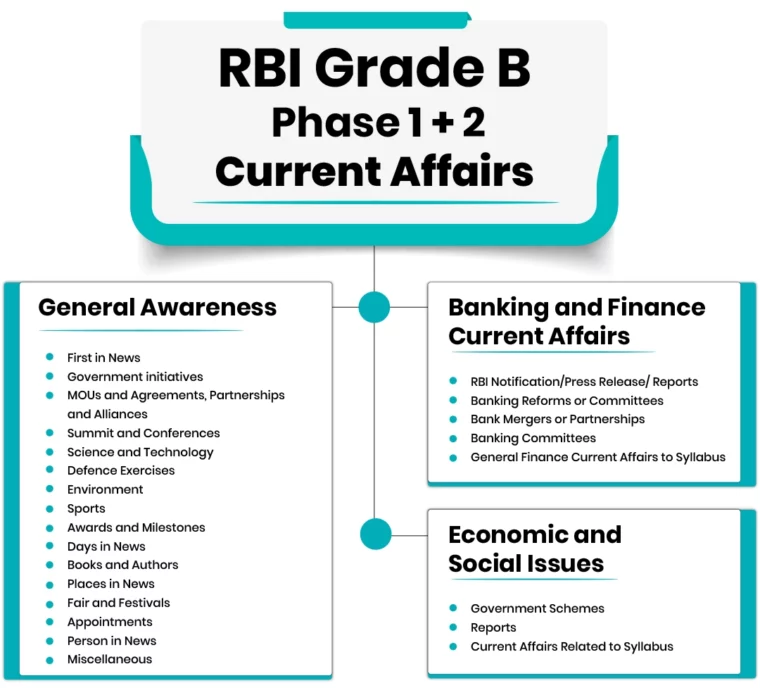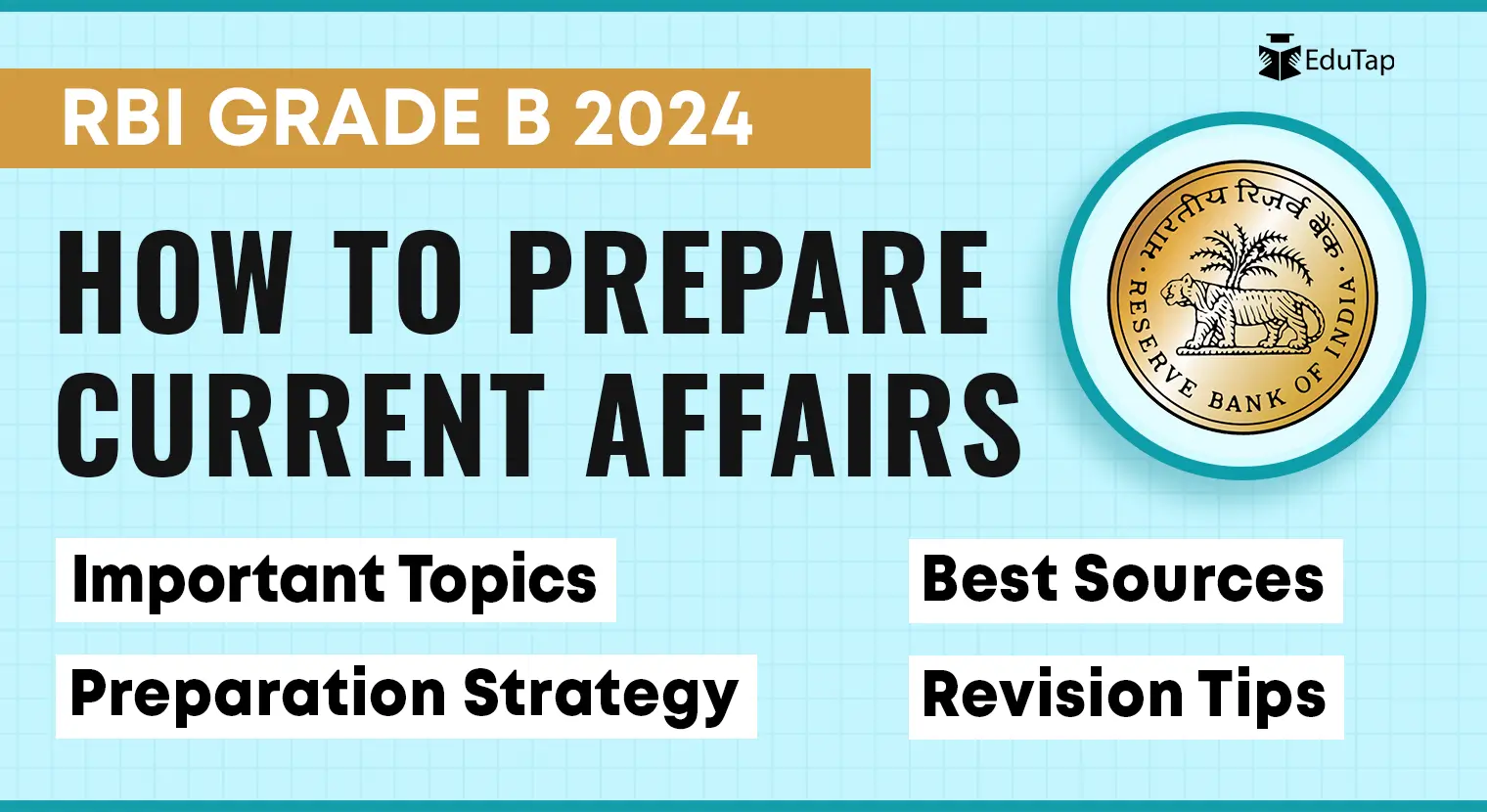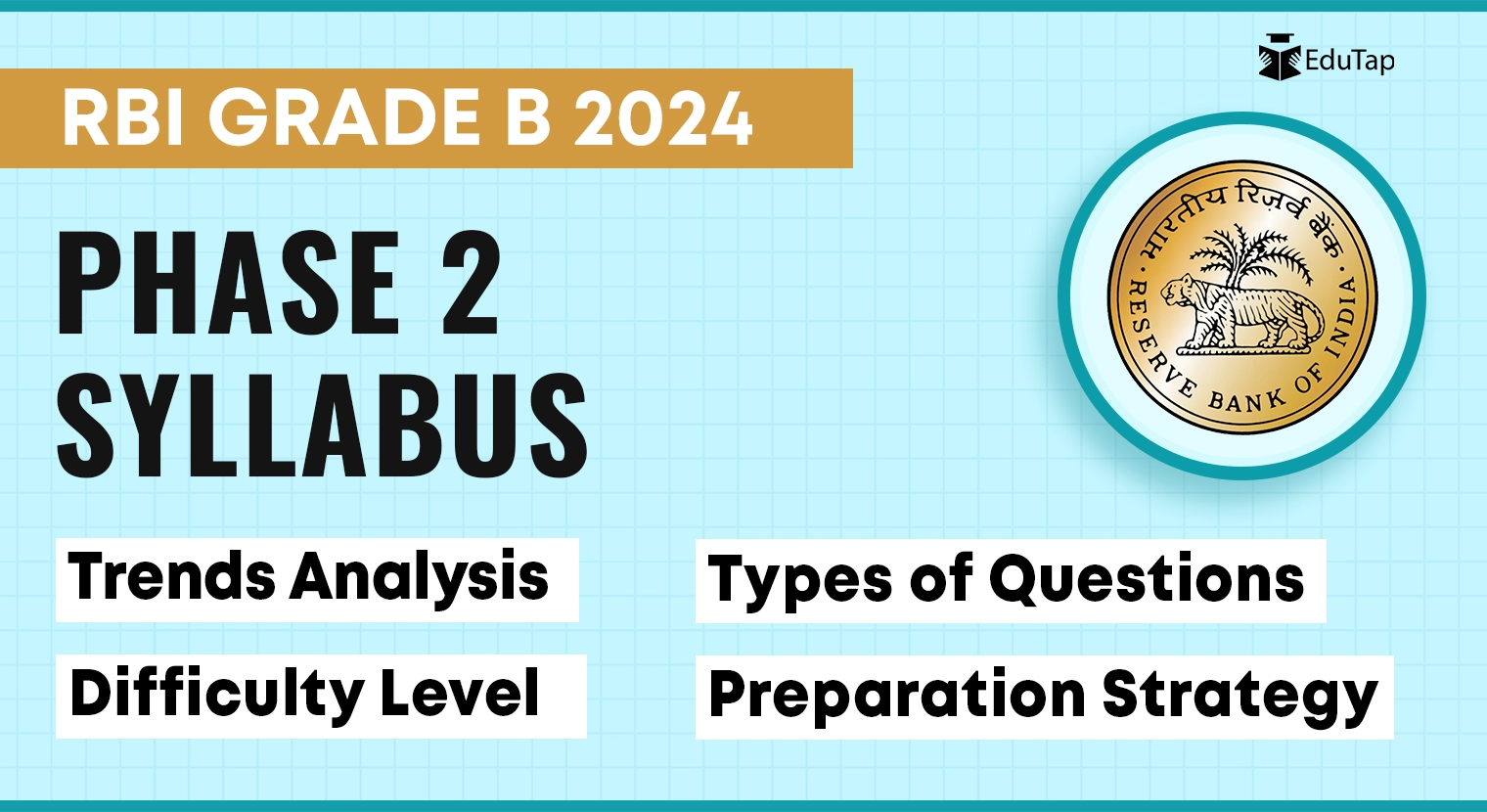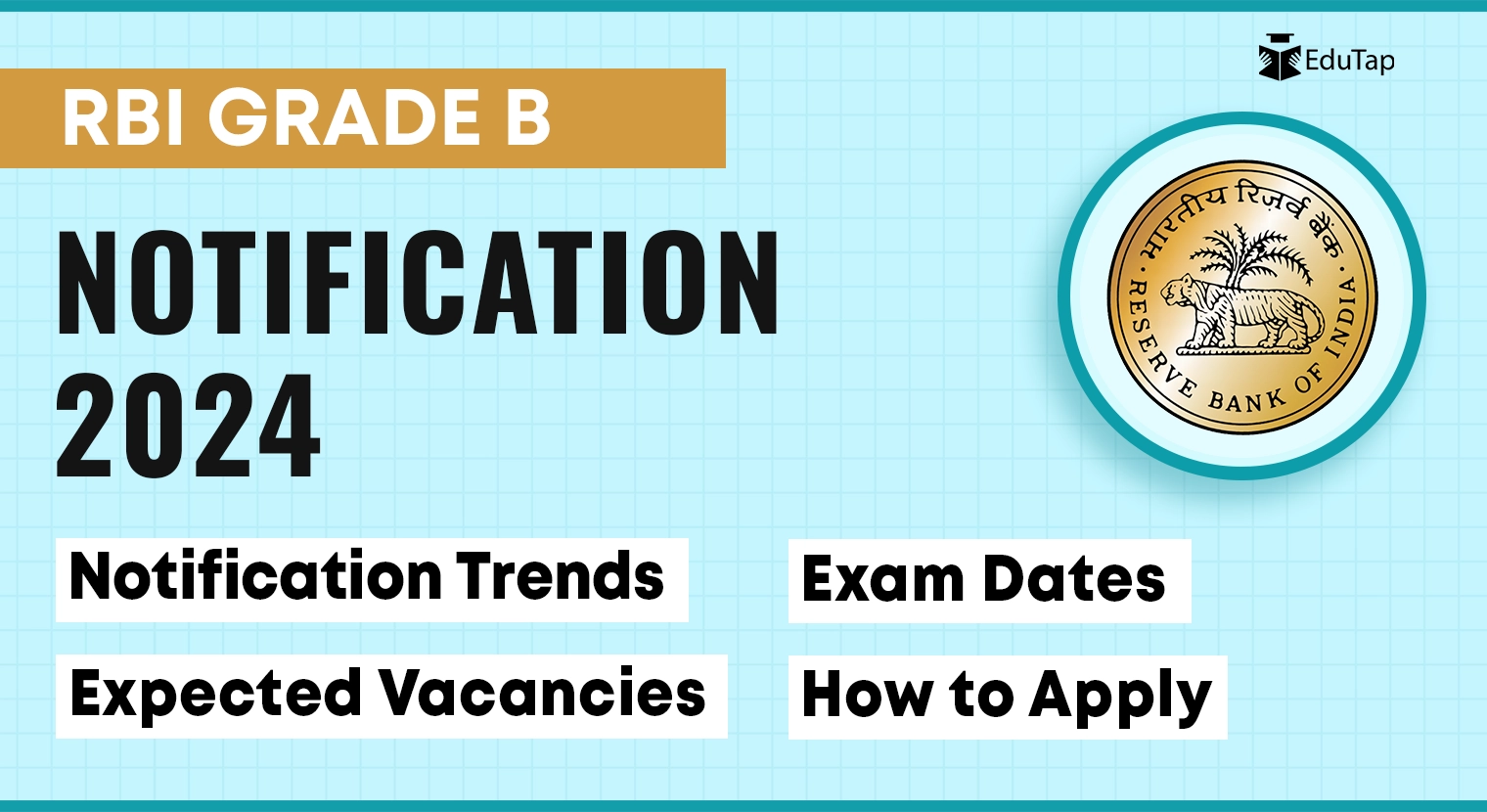Covering the vast syllabus of RBI Grade B current affairs can be challenging for many aspirants. The extensive information poses a challenge, making retention a significant hurdle in the RBI Grade B current affairs preparation journey.
In this article, we’ll explain how to prepare current affairs for the RBI Grade B 2024 by explaining “what to study”, “how many months to study”, and “how to study”. But before jumping to the preparation strategy, let’s understand how to approach current affairs.
Integrated Approach for Current Affairs Preparation
Many aspirants often wonder whether they should prioritise reading current affairs for Phase 1 or Phase 2 of the RBI Grade B exam. The key is to approach current affairs preparation in an integrated manner, without a distinct separation for Phase 1 and Phase 2.
For instance, Phase 1 current affairs encompass three sections: General Awareness, Banking and Finance Current Affairs, and ESI Current Affairs. If you focus on preparing for ESI and Banking and Finance current affairs in Phase 1, you are simultaneously covering topics relevant to Phase 2. However, it is important to note that the difficulty level of Phase 2 is higher than Phase 1.
This integrated approach ensures comprehensive current affairs preparation across both RBI Grade B exam phases.
Now that you have understood the integrated approach for preparing current affairs, let’s identify the important topics.
Important Topics for Current Affairs
Here are the important broad topics for current affairs:
- Economic and Social Issues
- Banking and Finance Current Affairs
- General Awareness

As mentioned earlier, ESI and Banking and Finance current affairs are relevant for Phase 1 and 2, while general awareness is primarily asked in Phase 1.
Below, we have explained the important topics to prepare from these broad current affairs topics.
1. Economic and Social Issues
Here are the important topics of Economic and Social Issues:
- Government Schemes
- Reports
- Economic and Social Issues Current Affairs Related to Syllabus
1. Government Schemes
Below, we have mentioned how to cover Government Schemes:
- Identify the Scheme: Clearly understand the name and purpose of the scheme.
- Eligible Beneficiaries: Identify the target group or individuals benefiting from the scheme.
- Nodal Ministry: Know the ministry or department responsible for implementing the scheme.
- Launch Year: Understand when the scheme was introduced.
- Funding Pattern: Know how the funding is distributed.
- Objectives: Understand the goals and aims of the scheme.
- Budget Allocation: Be aware of the financial allocation for the scheme.
- Current Developments: Stay updated on any recent changes or developments related to the scheme.
- Tagline: Know the slogan or tagline associated with the scheme.
- Associated Company for Implementation: If applicable, be aware of any external organisations or companies involved in implementation.
- Associated Brand Ambassadors: Identify any individuals or personalities associated with promoting the scheme.
Let’s take an example for a better understanding.
Question: Which of the following statements are correct with respect to the following Apprenticeship Training Scheme?
- It has been extended till 2026.
- It comes under the Ministry of Skill Development and Entrepreneurship.
- It provides a Rs. 9000 per month allowance to graduates and diploma holders in engineering, science, and business.
In the above-mentioned question, instead of asking one question, the examiner has asked multiple statements from the scheme. Here, the initial option addresses current developments, the second option discusses the Nodal Ministry, and the third option inquires about the objectives of this scheme.
If you have thoroughly covered the schemes, you can easily attempt these types of questions.
2. Reports
- Released by: Identify the organisation or entity responsible for releasing the report.
- About the Reports: Understand the purpose, scope, parameters, edition, and main focus of the report.
- Ranking (Both Global and India): Take note of any rankings provided, both on a global scale and within India.
- Key Findings (Both Global and India): Extract and comprehend the primary discoveries presented in the report, both globally and in the Indian context.
- Recommendations: Pay attention to any suggestions or recommendations proposed in the report, as they may have implications for various sectors or policies.
When covering reports for RBI Grade B current affairs preparation, focus on the following details:
Let’s take examples for a better understanding.
Question 1: Recently, the State of the World’s Forest 2022 (SOFO 2022) was released by the ____________?
Question 2: As per State of the World’s Forest 2022 (SOFO 2022), forests cover ____% of the global land area.
The initial question seeks information about the entity or organisation that released the report, while the second question inquires about the report’s key findings.
Again, if you have thoroughly covered the reports, you can easily attempt these types of questions.
Let’s talk about the prioritisation of reports.
Prioritisation of Reports
Here is the prioritisation of reports for both Phase 1 and Phase 2.
| Prioritisation of Reports | ||||
| SNo. | Reports Released by | Related to syllabus | Relevance | Importance |
| 1 | International Organisations | Yes | Phase 1 | Very Important |
| Phase 2 | ||||
| 2 | National Organisations | Yes | Phase 1 | Very Important |
| Phase 2 | ||||
| 3 | Private Organisations | Yes | Phase 1 | Moderately Important |
| Phase 2 | ||||
| 4 | Private Organisations | No | Phase 1 | Important |
| Phase 2 | Not Important | |||
Prioritisation of reports in RBI Grade B exam preparation involves categorising them based on their source, relevance to the syllabus, and overall importance.
- International organisations’ reports hold significant weightage and are very important for Phases 1 and 2.
- Similarly, reports from national organisations are also crucial, carrying a high level of importance for both phases.
- Reports from private organisations, while relevant, are considered moderately important in Phases 1 and 2.
- On the other hand, reports from private organisations without direct syllabus relevance are still important in Phase 1 but are considered less relevant for Phase 2.
This strategic prioritisation helps candidates focus on the most impactful sources for effective and efficient current affairs preparation.
3. Economic and Social Issues Current Affairs Related to Syllabus
In the RBI notification, a detailed syllabus of ESI is given, and we need to read the current affairs related to these topics. Here are the important topics for Economic and Social Issues Current Affairs:
- Social Justice
- Sustainable Development and Environmental Issues
- Employment Generation in India
- Gender Issues
- Indian Political System
- Human Development
- Globalisation
- Monetary and Fiscal policy
- Measurement of Growth
- International Economic Institutions/Regional Economic Cooperation
- Indian Agriculture
- Social Sectors in India- Health
- Social Sectors in India- Education
- Industrial Developments in India
- Priorities and Recommendations of Economic Survey and Union Budget
- Social Structure in India
Let’s take examples for a better understanding.
- From the Social Justice topic, the questions can be asked on Pradhan Mantri Suraksha Bima Yojana, Atal Pension Yojana, etc.
- From the International Economic issues topic, the questions can be asked on summits such as G-20, International trades, financial crisis, etc.
- From the Regional Economic Cooperation topics, the questions can be asked on ASEAN, SAARC, etc.
- The questions can be asked from any news related to the IMF, World Bank, and WTO.
Here, you can find the Economic and Social Issues Syllabus of RBI Grade B.
2. Banking and Finance Current Affairs
Here are the important topics of Banking and Finance Current Affairs:
- RBI Notification/Press Release/Reports
- Banking Reforms or Committees
- Bank Mergers or Partnerships
- Banking Committees
- General Finance Current Affairs to Syllabus
1. RBI Notification/Press Release/Reports
Keep a close eye on notifications, press releases, and reports issued by the Reserve Bank of India. It includes the RBI annual report, financial stability reports, important guidelines related to banking and finance, etc. We have already explained how to prepare reports in the above section.
Let’s take an example for a better understanding.
Question 1: The Union government, in consultation with the RBI, fixes the inflation target for the central bank every five years. The Upper Tolerance level of Inflation is ____________, and in case of a breach of the upper tolerance for ___________ quarters, the report has to be submitted
by RBI.
A. 4.0%, three consecutive quarters
B. 5.0%, two consecutive quarters
C. 6.0%, two consecutive quarters
D. 6.0%, three consecutive quarters
E. 5.0%, three consecutive quarters
2. Banking Reforms or Committees
Stay updated on any reforms in the banking sector, including forming committees to improve or restructure banking practices.
3. Bank Mergers or Partnerships
Changes in the structure of banks can have significant implications for the financial sector. So, understanding the latest developments related to mergers or partnerships involving banks is important for preparing RBI Grade B current affairs.
4. Banking Committees
Understand the roles and recommendations of various banking committees. These committees play a vital role in shaping policies and regulations in the banking industry.
5. General Finance Current Affairs related to Syllabus
Stay informed about broader financial current affairs that may impact the banking sector. Here are the important topics for Finance Current Affairs.
- Primary and Secondary Market
- Banking System in India
- Fintech
- Financial Inclusion
- RBI and Its Functions
- Recent Developments in the Financial Sector
Let’s take an example for a better understanding.
Question 1: Choose the right statement about Primary and Secondary Markets.
- Primary Markets Cater to new Issues of Capital whereas Secondary Markets Cater to new Issues of Debt
- Primary Markets Cater to new issues of Capital whereas Secondary Markets Cater to transfer of ownership among the existing Owners or from existing to new Owners
- Primary Markets Cater to the transfer of ownership among existing owners whereas secondary markets cater to the transfer from ownership from existing to new Owners
- Primary Markets Cater to new Issues of Debt whereas Secondary Markets Cater to new Issues of Equity
- None of the Above
This above-mentioned question has been asked from the General Finance and Management syllabus (Financial Markets- Primary and Secondary Markets). To answer these types of questions, you need to thoroughly read the current affairs of the topics mentioned in the syllabus.
Here, you can find the General Finance Syllabus of RBI Grade B.
Here is a video explaining the most important 50 Terms for Banking Awareness.
3. General Awareness
Here are the important topics of General Awareness:
- First in News
- Government initiatives
- MOUs and Agreements, Partnerships and Alliances
- Summit and Conferences
- Science and Technology
- Defence Exercises
- Environment
- Sports
- Awards and Milestones
- Days in News
- Books and Authors
- Places in News
- Fair and Festivals
- Appointments
- Person in News
- Miscellaneous
The questions can be asked directly or indirectly from these topics in the RBI Grade B Phase 1 exam.
Important Note: Out of the above-mentioned topics, the First in News and Government Initiatives are the most important general awareness topics.
Let’s take an example for a better understanding.
Question 1: Nand Mulchandani has been appointed as Chief Technology Officer of ____.
Question 2: ISRO has announced the launch of a spacecraft to orbit Venus, Which is scheduled by the year_____.
These two questions are examples of the First in News and Government Initiatives.
Now that you have understood the important current affairs topics to prepare for the RBI Grade B exam, let’s take a look at the important sources to prepare from.
Important Sources for Current Affairs
Below, we have mentioned some of the best sources to prepare for the RBI Grade B current affairs:
- Reports: The Hindu ePaper
- Schemes: Press Information Bureau Government of India
- Finance Current Affairs: Livemint
- ESI Current Affairs: The Hindu ePaper
- RBI Notifications: RBI Website
These are the important sources that can help you prepare for the current affairs of the RBI Grade B exam.
Important Notes:
- While preparing for the exam, it is essential to identify which sources to start with. You simply cannot start reading all these sources simultaneously. The best strategy is to pick any one source and follow it diligently. You can complement it with the PIB (if you can).
- Moreover, daily read at least one editorial of the newspaper you are following. However, make sure that it is related to the syllabus.
Here, you can find the General Awareness Syllabus of RBI Grade B.
Other Resources for Current Affairs
| Current Affairs Free Study Material | ||||||
| SNo. | Name of Series | Current Affairs Topic | Frequency of Sessions | Days Allotted | Live Session Timing | Link |
| 1 | CT360 | GA+ ESI Current Affairs(Phase 1 & 2) | 3 Days per Week | Tuesday, Thursday, and Saturday | 5.00 PM | Watch Now |
| 2 | Finance360 | Finance Current Affairs(Phase 1 & 2) | 3 Days per Week | Monday, Wednesday, and Friday | 10.00 AM | Watch Now |
| 3 | Perspective360 | Issue-based Current Affairs(Phase 2) | 3 Days per Week | Monday, Wednesday, and Friday | 5:00 PM | Watch Now |
Join these Live YouTube sessions to cover GA, ESI, Finance, and Issue-Based current affairs.
Download the RBI Grade B Current Affairs PDF.
Now that you have understood the important sources to prepare RBI Grade B current affairs, it’s time to understand how to read the PIB website.
How to Cover the PIB Website for RBI Grade B Current Affairs
To understand how to cover the PIB website, you need to identify the following.
- How many months do you need to cover?
- Which news to cover?
- What to cover in the news?
Below, we have answered these questions in detail.
1. How Many Months Do You Need to Cover?
5 months is the ideal duration to cover the PIB website for RBI Grade B Phase 1 current affairs. However, if time is a constraint, it is important to cover at least the immediate preceding 3 months.
For phase 2, covering the 9 months of PIB current affairs is recommended. However, if you find it difficult to retain so much information or if time is a constraint, it is important to cover at least 6 months of current affairs.
2. Which News to Cover?
Visit the official PIB website (https://pib.gov.in/) and select the press release tab, followed by all releases. Here, you can choose the ministries you need to cover. Here is the list of important ministries.
- Ministry of Health and Family Welfare
- Ministry of Education
- Ministry of Urban Development
- Ministry of Child and Women Development
- Ministry of Labor and Employment
- Ministry of Environment, Forest, and Climate Change
- Ministry of Agriculture and Farmers Welfare
- Ministry of External Affairs
- Ministry of Commerce and Industry
Important Note: Besides these important ministries, if time permits, you should also cover the other ministries, such as drinking water and sanitation, jai shakti, power, railway, rural development, etc.
3. What to Cover in News?
You need to cover facts and extrapolate from the PIB news. It is also important to check the “background of the program”, which is mentioned at the end of every article. It gives you lots of information that can help you answer many questions in the exam.
Here is a video explaining how to cover the PIB current affairs for the RBI Grade B in detail.
Now that you have understood the important RBI Grade B current affairs sources, let’s take a look at how many current affairs months you need to cover for the exam.
Coverage of Current Affairs
In the ideal preparation plan, covering the past 9 to 10 months of current affairs is essential for the RBI Grade B Phases 1 and 2. Moreover, you need to devote at least 4 to 6 hours daily to cover this much of the current affairs syllabus. Now, devoting this much time just to current affairs is not possible for any aspirant, especially for working professionals.
For Phase 1
Ideally, 5 months (immediately preceding your exam) of current affairs are enough to cover 80 to 85% of the syllabus, provided you cover 5 months thoroughly. The remaining 15 to 20% of questions are asked from 6 to 10 months. After completing the past 5 months’ current affairs, you can cover these months’ current affairs if time permits.
However, if time is a constraint, you can consider the mixed approach to prepare the current affairs for the RBI Grade B Phase 1. The mixed approach includes 3 months of current affairs along with the MCQs of the 4th and 5th months. This strategy can help you cover 65 to 70% of the syllabus.
For Phase 2
Ideally, 8 months (immediately preceding your exam) of current affairs are enough to cover 90% of the syllabus, provided you cover 8 months thoroughly. The remaining 10% of questions are asked before the 8 months.
However, if time is a constraint, you can consider the mixed approach to prepare the current affairs for the RBI Grade B Phase 2. The mixed approach includes 6 months of current affairs along with the MCQs of the 7th and 8th months. This strategy can help you cover 70% of the syllabus.
Important Note: You must cover the current affairs till a week before the examination for Phases 1 and 2.
Now that you have understood how many months of current affairs you need to prepare for the RBI Grade B exam, let’s understand the current affairs preparation strategy.
How to Prepare for Current Affairs
Follow these below-mentioned steps to revise the current affairs:
1. Understand the Current Affairs
Like quant and reasoning, current affairs is a topic that needs to be understood instead of cramming. If you are reading a scheme or report, you need to understand the same, helping you to retain the information easily.
2. Start with the Government Scheme
Start your preparation by understanding 2 schemes and 1 RBI notification weekly. By understanding, we mean thoroughly understanding the crux of the topic.
Let’s take an example of Sovereign Gold Bond. You need to understand who issues these bonds, who will be taking these bonds, etc., to get the basic crux of the topic.
3. Daily Read One Editorial
Incorporate a daily habit of reading at least one editorial relevant to your syllabus to enhance your understanding and stay informed.
Important Note: We have already explained how to prepare schemes, Reports, and the PIB website above in the article.
After understanding how to prepare for current affairs, it’s time to learn tips for current affairs revisions.
Current Affairs Revision Tips
Follow these below-mentioned tips to revise the current affairs:
1. Be Consistent
Consistency in preparing for RBI Grade B current affairs involves establishing a regular and dedicated study routine. It means allocating a specific time each day or week to focus on current affairs topics. Consistency ensures that you understand and retain the information over time.
2. Practise MCQs
Practise as many MCQs as possible. Keep in mind that you need to answer 80 questions in 25 minutes during the RBI Grade B Phase 1. Aim to practise around 40 questions in 10 to 12 minutes to build speed.
Moreover, you need to answer 30 questions in 30 minutes each for the ESI and Finance and Management papers of RBI Grade B Phase 2. Practising for Phase 1 can help you easily answer questions in Phase 2.
This training approach helps condition your mind to perform efficiently within the time constraints of the actual exam.
3. Analyse Your Mistakes
After completing your MCQ practice, take the time to analyse your mistakes thoroughly. This involves
- Revisiting the questions you got wrong
- Understanding the reasons behind your errors
- Identifying any patterns or trends in the types of questions where you face challenges.
This analysis is crucial for learning from your mistakes, refining your approach, and ensuring continuous improvement in your RBI Grade B exam preparation.
4. Do at least 5 Revisions Before the Examination
Revision is the most important part of your RBI Grade B current affairs preparation strategy. You must aim to revise the current affairs at least 5 times before the exam. Below, we have mentioned the perspective of 5 revisions.
Revision 1: Read the whole document
Revision 2: Highlight the important points
Revision 3: Solve multiple MCQs
Revision 4: Analyse your mistakes and note them down
Revision 5: Revisit your mistakes and ensure you understand them accurately
Here is a video explaining how to prepare current affairs RBI Grade B in detail.
Conclusion
Preparing for RBI Grade B Current Affairs demands a strategic and consistent approach. The focus on critical areas such as government schemes, reports, and important topics in banking and finance ensures a comprehensive understanding. Engaging in regular MCQ practice, timely revision, and consistent analysis of mistakes can solidify your preparation.
Remember, consistent efforts, a well-structured study plan, and effective revision are the keys to conquering the challenges the RBI Grade B Current Affairs section poses.
FAQs
It is recommended to cover current affairs until one week before the exam. Staying updated with recent developments ensures you are well-prepared for any last-minute changes or additions.
The time required to prepare for RBI Grade B current affairs varies for each candidate based on their prior knowledge, study habits, and understanding of the subjects. On average, a dedicated and consistent study routine of 6 to 7 months is recommended for comprehensive preparation.
Yes, reading editorials related to the syllabus helps you gain a deeper understanding of the topics and provides insights into various perspectives.
Practise regular revision, read at least one editorial related to the syllabus daily, and solve multiple-choice questions (MCQs) to reinforce your learning.





